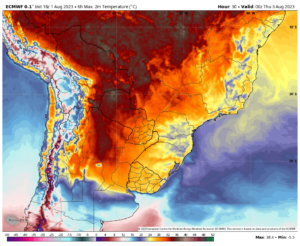
As human beings, we have infinite capacity for empathy.
We also have the capacity to be blind to what is going on in the world around us.
This dichotomy is why some people see the Sarah MacLachlan ASPCA ads and donate, others click to another site as fast as possible, and then some just ignore them.
This complex reaction to emotional topics is why even our team struggles to communicate climate change science.
Put simply, there are human consequences fundamentally entwined with the discoveries being made, and to understand climate science is to force yourself to also understand those human consequences – and sometimes we all just want to look away. But it really is in the best interests of humanity for us to look at climate change in the science and understand what is going on.
As I pull together the content for this story, I’m was watching the hourly weather predictions for Southern Illinois wildly change as meteorologists struggled to understand how to foretell the future from the patterns of temperature, pressure and humidity seen by weather networks. There is a chance we’ll have tornadoes and a watch is in place. There is also a chance we’ll keep having clear blue skies and negligible wind. And… every hour or so, the predictions change.
For a while, computer models had gotten really really good at predicting weather, but right now we’re contending with inputs the models just can’t handle: the oceans are hotter, the poles have less ice, and many other global changes have wrecked the frameworks those models are built within.
This is a story 20 years in the making.

In February 2003, the journal Nature ran a story on the Atlantic circulation patterns. Written by Stefan Rahmstorf, this article summed up what we understand about how the Atlantic circulates warm water from tropical regions northward, and cold waters from more Arctic regions southward.
This circulation pattern and the prevailing winds together explain how London, England can be further North than the Canadian city of Calgary and have palm trees and winter rain while Calgary is more better known for brutal winters and summer highs in the low 70s.
As this 2003 article points out, models show that changes in circulation could change European temperatures by up to 20 degrees Celsius or 46 degrees Fahrenheit.
The easiest way to collapse those circulation patterns would be to dump too much fresh water – such as from melting sea ice and glaciers – into the ocean, and thus change it’s salinity and density.
Rahmstorf was the person to know just how worried we need to be. In a September 2002 paper in Nature, he wrote a review of the Ocean circulation and climate during the past 120,000 years as part of an issue with a series of review articles on climate. It was an amazing issue that I still remember reading. It was the first time it was brought home to me that we were on the edge of taking our planet into a new climate regime that is beyond anything our planet had seen before.
As written in a different article by Lee Kump:
The lack of an adequate ancient analogue for future climates means that we ultimately must use and trust climate models, evaluated against modern observation and our best geologic records of warm and cold climates of the past. Armed with an elevated confidence in the models, we will then be able to make reliable predictions of the Earth’s response to our risky experiment with the climate system.
Kump, L. Reducing uncertainty about carbon dioxide as a climate driver. Nature 419, 188–190 (2002). https://doi.org/10.1038/nature01087
Back in 2003, the interactions between greenhouse gases, geology, and our changing Sun were still being debated, and while climate change was generally accepted among scientists, the role of humans was still being debated.
I have to admit, a lot of us believed that as soon as we could get society to accept what the release of greenhouse gasses was doing to the environment, there would be global action to do whatever was needed to reverse the heating of our planet.
Afterall, as a child of the 80s and 90s, I lived through both the era of really big hair and ozone layer destruction, and the era of really flat hair, the illumination of chlorofluorocarbons, and the subsequent healing of the ozone hole.
When things change too much, the world find a new normal

On July 25 of this year, 2023, Rahmstorf’s 2003 article was cited in a new paper in Nature. Written by Peter and Susanne Ditlevsen, this article is titled “Warning of a forthcoming collapse of the Atlantic meridional overturning circulation”, and it cautions that weakening of the circulation patterns are already starting to be seen. While the estimate full collapse is unlikely to occur in this century, it may happen before today’s children grow old, and while their children are the leaders of a starkly different world.
In this new paper, they explain, “When complex systems, such as the overturning circulation, undergo critical transitions … , a structural change in the dynamics happens. The previously statistically stable state ceases to exist and the system moves to a different statistically stable state.” Put another way, when the variables change too much, the stable world that we knew finds itself a new normal.
We are currently seeing that structural change, and if we aren’t careful, we’ll experience a new stable state.
Locally, many of us are seeing weather that is more extreme: wetter, dryer, hotter, colder. If something could be more extreme … it probably has been. While we here in the Northern Hemisphere swelter under 100 degrees Fahrenheit summer temperatures and complain, it’s at least normal to be hot in summer.
Currently, it should be the deepest of winter in the Southern Hemisphere. Due to the slight ellipticity of Earth’s orbit, Southern winters are generally a bit colder than Northern, and Antarctica is a bit more extreme than Arctica.
Currently, temperatures in South America are also nearing 100 degrees Fahrenheit. On August 1, it reached 86 deg. F. in Buenos Aires, where the normal high is just 58 deg. F.. There were even higher temperatures in the Andes. In some places, the temperatures reached all time highs. Not all time highs for that particular day of the year, but rather the all time highest temperature ever measured. Along with these South American highs, Antarctica is seeing less formation of sea ice, and massive icebergs – one the size of Greenland – are breaking away from the continent to melt in the sea.
While South America bakes, Slovenia and the Beijing region are flooding, and hail bombards locations scattered around the globe.
These dramatic excursions in temperature are being caused by pressure and temperature changes in the atmosphere that allow heat domes and Arctic domes to plunge places into extremes for days and sometimes weeks at a time. These weather events are a taste of what our world will look like when the average temperature rises globally by 1.5C or 2.7F. That is the temperature change we want to avoid… but in the month of July, 1.5C is the change in average temperature the world experienced.
What factors create these changes
Back in 2003, when I read that set of review papers, researchers did everything they could to understand all the ways that greenhouse gasses are entering our environment and how changes to our environment will in turn change how our planet absorbs and reflects heat.
We got a lot of things right. We understood that ice is really good at reflecting light and the loss of ice would accelerate the heating of our world as more light is absorbed and able to warm waters and lands.
We also totally missed a bunch of things. Permafrost is melting in ways we never imagined and opening up amazing sinkholes in places like Siberia.
The largest of these melts is Batagaika Crater in Siberia. Recent arial footage highlights how this feature is literally unzipping the Siberian landscape. Today, the feature, which is also called the ‘Doorway to the Underworld’, is roughly a kilometer long, 100 meters wide, and growing about 10m a year.
While paleontologists are getting an amazing opportunity to study freshly revealed ancient plants and, climate scientists are seeing massive volumes of greenhouse gas released from the melting ices and decaying now-thawed plant matter. It’s estimated that up to 200,000 years of historical climate records are revealed in the layering of the landscape. As well as potentially previously extinct viruses and bacteria. … and a worm. Researchers actually revived a roundworm that survived frozen for 46,000 years 40m below the surface in Siberia.
Right now, it is – I hope – impossible for people to not acknowledge the cost climate change is having. From the literal costs of heating and cooling to the human costs of dangerous flooding, tornadoes, and other weather… this is a cost our society can’t afford.
Folks, it’s time to do what we did with the ozone hole; it’s time to change international rules and abide by the changes and find ways to fix the harm we have done. We’re going to need to do more than update our AC and get rid of our hairspray – but if we have a will, we, as a planet, just might be able to return our world to the stable place we knew before.
